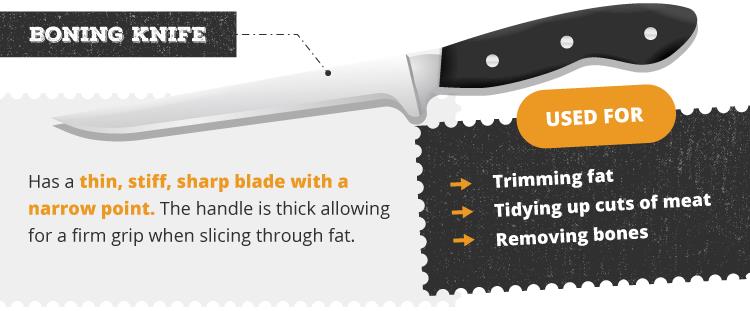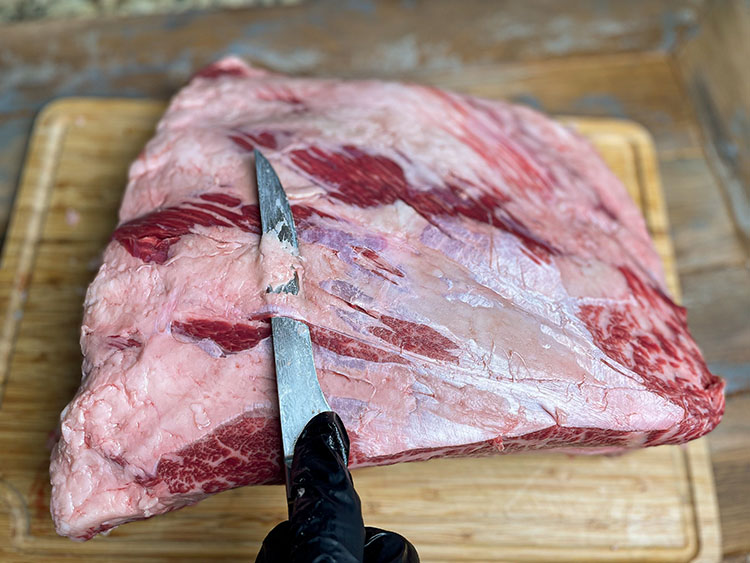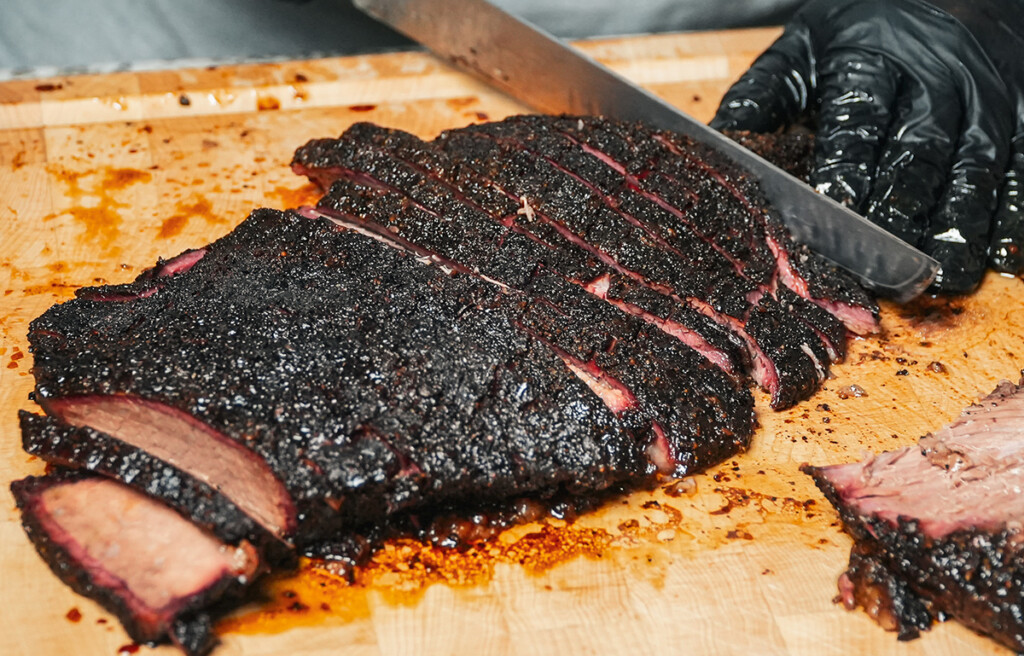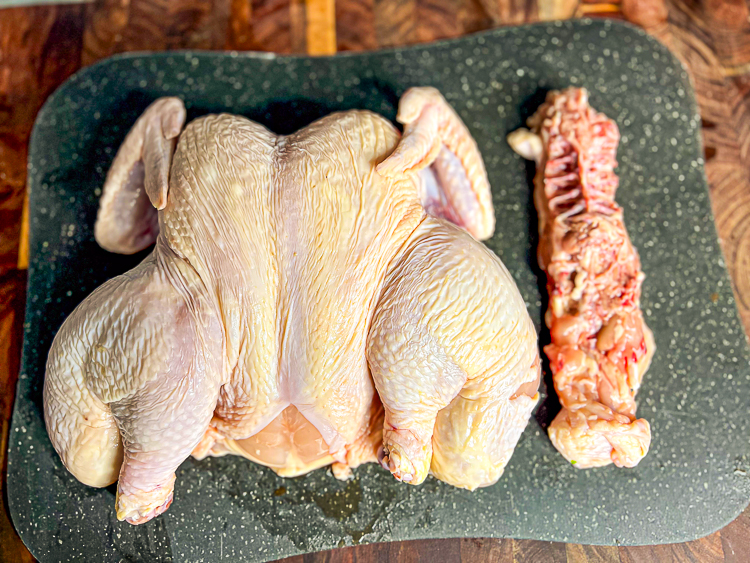Having the right knife for the job helps ensure your barbecue doesn’t resemble roadkill, despite the hours of work you put in.
Luckily, you don’t need to go nuts and spend $300+ on a handcrafted Japanese steel knife. With just three knives, you can assemble a knife collection you could take on the barbecue competition circuit.
Best knives for BBQ cooks
Let’s cut to the chase. When it comes to barbecuing, you don’t need a drawer full of knives to cover every slicing and dicing need. In fact, with the three types of knives we have listed below, even at the competition level, you will have everything covered.
1. Boning Knife

A boning knife has a thin, stiff, and sharp blade with a narrow point. This is attached to a thick handle, allowing for a firm grip as you slice, de-bone, and trim.
What’s a boning knife used for?
A boning knife is the best knife to have in your collection because it’s incredibly versatile and can get in and around practically any bone put in its path. Here are just some uses:
- Trimming fat – For example, a fat cap off a beef brisket.
- Tidying up cuts of meat – Squaring up a rib rack. Use the boning knife to trim up the smaller bone end and remove the skirt piece and backbone.
- Removing bones – Like if you need to butterfly a leg of lamb. The narrow point is also perfect for removing smaller, fiddly bones such as those found in chicken and fish.

Using a boning knife to trim the fat off beef short ribs.
In the video below, you can see how Aaron uses the boning knife to remove the plastic and trim the fat off the brisket.
Boning knife recommendation
We designed our Smoke Kitchen 6.5” Boning Knife specifically for barbecue. The VG-10 steel carbon and chromium blend blade maintains its sharpness for a long time and resists rust.
It’s perfect for delicate tasks requiring precision, such as removing silverskin. It’s also up to scratch for heavier-duty jobs like preparing meat before smoking.
You’ll appreciate how the perfectly balanced and easy-to-grip knife fits in your hand, allowing you to work quickly and safely.
2. Slicing Knife
 A slicing knife has a long blade that’s either slightly curved or rounded at the tip. They often have hollows in the blade where air, fats, and juices accumulate, allowing for smooth movement through the meat and preventing tearing.
A slicing knife has a long blade that’s either slightly curved or rounded at the tip. They often have hollows in the blade where air, fats, and juices accumulate, allowing for smooth movement through the meat and preventing tearing.
What’s a slicing knife used for?
As expected, a slicing knife is primarily used to make uniform meat slices before serving. It can be used on small cuts like sausage or pork belly, but it comes into its own on big meat cuts, such as beef brisket or ham.
 Because of the size, you really need a long blade to slice brisket.
Because of the size, you really need a long blade to slice brisket.
The long, sharp blade makes it easy to slice through any type of meat in one clean go. The beautifully cut, thin slices ensure your end product is worthy of an award, and there are no jagged edges in sight.
Slicing knife recommendation
Our post on the best knife for slicing brisket includes several recommendations. But you can expect excellent performance from the Smoke Kitchen 12” Meat Slicing Knife, whether you’re slicing hot brisket or cold bacon. It performs with ease on any task.
The long 12-inch blade is made from the same material as the boning knife, allowing you to cut briskets and hams with one smooth stroke, without the need for multiple cuts. This ensures that your expertly smoked meat not only tastes great but looks fantastic.
This knife also has a “Granton” blade, meaning it has scallops that create air pockets so the as the meat doesn’t stick to the blade as it slices through.
Hot tip: There’s a difference between slicing and carving knives. The latter is thicker and less flexible with a pointed tip. A slicing knife will always give you better and more precise cuts.
3. Chef’s Knife
The chef’s knife has a thicker, almost triangular-shaped blade with a pointy end. Sometimes these knives will have a scalloped blade.
What it is used for:
This is another versatile knife to have in your arsenal for… well, whatever you need. A high-quality chef’s knife can be used before and after grilling for cutting, chopping, slicing, and trimming.
It also has the deepest blade out of these three knives, so it’s great for cutting into thicker items. I like to use it mostly to prepare sauces and sides.
Chef’s knife recommendation
The Victorinox 10” Swiss Classic Chef’s Knife has balanced the characteristics of the steel in this knife perfectly.
It’s soft enough to sharpen easily yet hard enough to hold the edge. Made of lightweight steel, which surprises some people, we promise it’s just as tough as heavier-steel competitors.
Hot tip: We personally don’t recommend buying a knife set because you can’t control what’s included, and you typically pay for low-quality and unnecessary filler items.
Bonus BBQ knives we recommend
Here are the useful “nice to have” knives that we recommend but aren’t mandatory for a quality BBQ experience.
- Cleaver: With a thick, heavy blade, a meat cleaver or butcher’s knife is great for breaking up the meat fibers using a chopping action. It’s the best knife for cutting through sinew, bone, and tough meat.
- Paring knife: A paring knife is worthwhile for a meatless barbecue. It’s a go-to for prepping vegetables and side dishes.
- Kitchen shears: Not a knife per se, but kitchen shears are handy for spatchcocking chicken and tidying up fat.
 While a boning knife can do the job, kitchen shears are much faster for spatchcocking a chicken.
While a boning knife can do the job, kitchen shears are much faster for spatchcocking a chicken.
Caring for your barbecue knives
Once you’ve invested in decent knives, you’ll want to care for them properly so they go the distance. Here are our top tips for ensuring you get the most out of your knives.
- Don’t put your knives in the dishwasher. This should be common knowledge, but every time I have a guest over and they offer to wash up, I end up having to swoop in at the last second to rescue my nice knives from the dishwasher. The heat and the harsh chemicals will damage them. Always hand wash your good knives.
- Get a honing steel and use it each time before you start to use your knife.
- Cut in a straight, smooth motion, and avoid twisting and bending the blade.
- As tempting as it may be when you notice a loose screw on your smoker, do not use your knife as a backyard tool/screwdriver!
- Make sure you dry your knife thoroughly before you put it away. Using a paper towel might even be a good idea, as dishcloths can hold moisture and leave your knife damp and prone to rust.
- If you notice rust on your blade, clean it off as soon as possible to stop it spreading. Use rust cleaner or a rust eraser if the rust is a little heavier.
- Use a wood or bamboo chopping board and avoid the plastic ones that blunt your knives.
Did you miss our previous article...
https://manstuffnews.com/backyard-grilling/soy-braised-spare-ribs
 Backyard GrillingWeekend WarriorsAdvice from DadBeard GroomingTV Shows for Guys4x4 Off-Road CarsMens FashionSports NewsAncient Archeology World NewsPrivacy PolicyTerms And Conditions
Backyard GrillingWeekend WarriorsAdvice from DadBeard GroomingTV Shows for Guys4x4 Off-Road CarsMens FashionSports NewsAncient Archeology World NewsPrivacy PolicyTerms And Conditions
